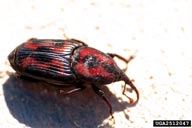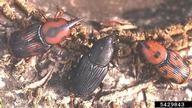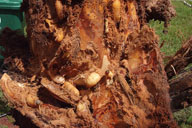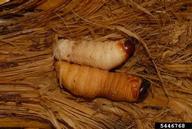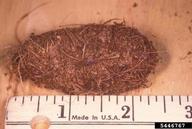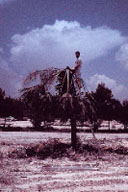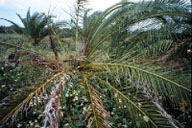Giant palm weevil
Rhynchophorus cruentatus (F.) (Coleoptera: Curculionidae)
Orientation to pest
Giant palm weevil (also called palmetto weevil), Rhynchophorus cruentatus (F.), is native to the West Indies, South America, and coastal areas of the southern United States. This species attacks various introduced and native palms. The adult is variable in color pattern. Adults emit aggregation pheromones to concentrate attack on stressed trees. Eggs are laid in the bases of leaves or in wounds in a dying palm. Larvae feed primarily in the soft tissue surrounding the apical meristem. Mature grubs migrate to the periphery of the stem or petioles and prepare a cocoon from palm fibers. The weevil attacks lightning-struck or stressed palms, such as ones that have recently been transplanted. Healthy palms in natural settings are rarely damaged.
Hosts commonly attacked
The giant palm weevil is closely associated with cabbage palmetto (Sabal palmetto [Walker] Loddiges ex J.A. et Schultes), which is native to the southeastern United States. The native saw palmetto (Serrenoa repens [Bart.] Small) is an alternate host. Infestations have also been found in several introduced palms such as the Canary Island date palm (Phoenix canariensis Hortorum ex Chabaud), Phoenix dactylifera L., Pritchardia sp., Washingtonia sp., royal palms (Roystonea sp.), Latania sp., coconut palm (Cocos nucifera L.), and Caryota sp.
Distribution
This weevil is found in the United States in areas where palms grow, from Florida to Texas and north along the coast to South Carolina.
Images of giant palm weevil
| Figure 1. Adult of giant palm weevil (also called palmetto weevil), Rynchophorus cruentatus. The adult is variable in color (right). | Figure 2. Larvae of giant palm weevil in Bismark palm (Bismarckia nobilis Hildebrandt and H.Wendl.) |
| Figure 3. Cocoon of giant palm weevil, inside of which the larva pupates | Figure 4. Sabal palm (Sabal sp.) killed by giant palm weevil (left), and Canary island date palm, Phoenix canariensis, killed by giant palm weevil (right) |
Important biological control agents related to this pest species
Natural enemies of this species are not reported from North America but some have been noted in other parts of its range. However, since this weevil is a native species in the United States and since damage occurs principally in planted palms in landscapes, the use of pesticides is likely to be an adequate and more efficient method of control.
Web links for information on giant palm weevil
Articles
- Giblin-Davis, R. M. and F. W. Howard. 1989. Vulnerability of stressed palms to attack by Rhynchophorus cruentatus (Fabricius) (Coleoptera: Curculionidae) and insecticidal control of the pest. Journal of Economic Entomology 82: 1185-1190.
- Giblin-Davis, R.M. and A. C. Oehschlager, A. Perez, G. Gries, R. Gries, T. J.Weissling, C. M. Chinchilla, J. E. Peña, R. H. Hallett, and H. D. Pierce, Jr. 1996. Chemical and behavioral ecology of palm weevils. Florida Entomologist 79: 153-167. (viewable at http://www.fcla.edu/FlaEnt/fe79p153.pdf)
